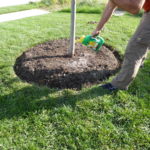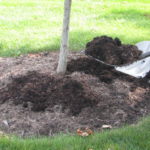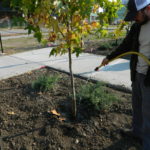Early fall is the time to begin preparing trees for the winter and get them off to a good start in the following spring. Preventative maintenance and some good cultural practices in autumn boost trees’ health and vigor during the winter and creates an encouraging growing environment in the spring. Here are 5 good tips for trees:
- Scout for pruning issues.
It’s advantageous to schedule pruning tasks after leaves have fallen. It’s much easier to see the branch structure of trees and deciduous shrubs in order to perform good selective cuts. Look for those non-beneficial plant parts and remove them. These include any dead, broken and crossing branches which can be removed. Also, search out and remove those epicormics sprouts in the canopy and basal sprouts emerging from around the trunk and root collar. Refer to this pruning publication for more information. - Feeding for the future.
Typically, tree roots have produce more root growth during the fall. Root systems are important as storage organs or banks to reserve energy for later. These stores of starch will become active energy on demand in the spring when shoot growth, leafing and flowering occur. Fertilization during this time will maintain soil nutrient levels and increase root production, promoting new growth in the spring. Newly, established trees and those younger trees are especially responsive to supplemental feeding. However, not all trees need or require fertilization. Refer to this publication on fertilization for more information.- Professional arborists can best feed mature trees
- Newly-established trees benefit from fertilizer
- Complete cultural practices.
It’s always beneficial to the tree to replenish mulch to give root systems an extra layer of protection against temperature extremes. This helps maintain the moisture levels in the soil during those drier winter months as well. Maintaining 2-3 inches of composted mulch over the root zone of the tree and landscape provides great protection. Also, it may be a good time to consider providing protective wraps on thin-barked or newly planted trees, if needed. Also, now is a good time for inspecting those existing wraps to be sure they are effective and not too tight around the trunk or harboring hidden pest issues.- Mulch provides a blanket of protection
- Good moisture levels going into the winter is critical for tree health
- Water needed, still.
The dry, cool air and low precipitation that can sometimes occur during fall and early winter can take a toll on trees. Provide supplemental irrigation with deep watering to prevent root damage and a good spring start. It is advisable to water only when temperatures will be above 40o Water around mid-day so there is time to soak in before the freezing night temperatures. Applying approximately 5 gallons water per inch of tree diameter will be adequate for times when there is little to no rainfall going into winter. - Take inventory.
This is a good time to assess your site for vacancies. Check your property for potential planting locations to install new trees next spring. Research during the winter allows plenty of time for good decision-making which includes proper species selection and suitable locations. Refer to the tree selection publication for more information.
There are many resources available to learn about proper tree care. If you are uncertain on how to maintain your trees or prefer professional services, it is important to reach out to an ISA Certified Arborist to help with the tree, within your landscape, especially the larger, mature trees. A Certified Arborist can proactively identify, analyze and evaluate your tree needs to maintain this important asset, your trees.




